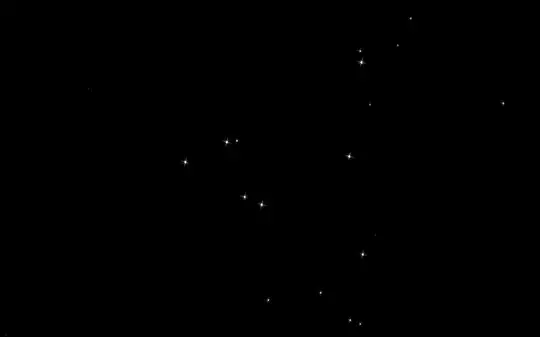I am writing down a draft trying to accurately characterize some nonlinear/noninvertible discrete dynamical systems (of a former question here) and due to my lack of knowledge I am having doubts here and there. This is my first doubt: as they are very disperse questions I would like to ask them individually one by one, as I advance in the draft:
Basically I have a family of dynamical systems defined as follows (Def. 1):
$$S_{D,t,f}=\left\{(x,y): (x_{n+1},y_{n+1}) = \left( \Im\left(\frac{1}{(x_{n} + y_n i+1)^{t}}\right)\sin{\frac{D}{f}}, \Re\left(\frac{1}{(x_{n} + y_n i+1)^{t}}\right)\cos{\frac{D}{f}} \right)\right\}$$
The control parameters are defined as time $t \in \Bbb N^{+}$, Depth $D \in [0,8 \cdot 10^3] \in \Bbb N$, and an initially fixed frequence $f=1$. Usually $n \in [0,8 \cdot 10^3]$ is a good enough interval to reach the associated attractor in all cases. Initially I am only interested in the region $[-5,5]×[-5,5]$, where the attractors finally are, after removing the transient regime. The initial condition is $(x_0,y_0)=(0,0)$, but initially it does not matter which seed I use because I am arriving to the same (periodic orbit and single point) attractors independently of the initial $(x_0,y_0)$ as far as the control parameters are fixed.
Initially I defined $x,y$ as the variables and $D, f$ and $t$ as the control parameters, but I am not sure about this. The question is related with that decision.
Defined as above, each one of the dynamical systems of the family is bi-dimensional (only $x$ and $y$ are variables). For instance, here is a zoom of the visualization of just one of the attractors, for $t=2, f=1$ and $D=136$ and iterating each one of them in $n \in [0,8 \cdot 10^3]$:
It is just a zoom of a little region inside $[-5,5]×[-5,5]$, showing some of the points of the complete $S_{D=136,t=2,f=1}$ attractor, which is a $73$-periodic attractor. The spark effect is just to make the points easier to see.
But the properties of these systems are more interesting when the whole family is visualized as a unique system including all the $D$ (Depth) integer bifurcations, than visualizing each one of the $D$-bifurcations individually, as it happened in the previous image. It looks like this, for instance for $t=2, f=1$ and showing all the bifurcations associated with $D \in [0,8 \cdot 10^3] \in \Bbb N$ and iterating each one of them in $n \in [0,8 \cdot 10^3]$ in the same image (click to zoom):
So it is a picture of the whole family of attractors associated to the $D$-bifurcations, all at once in the region $[-5,5]×[-5,5]$. It includes indeed the previous example of a single attractor of the family, $S_{D=136,t=2,f=1}$. It is possible to see that, while a single specific $D$ attractor has not a very clearly defined structure, the structure and symmetries of all the $D$ bifurcations together can be distinguished clearly.
Due to that, I am not sure if I should express the control parameter $D$ into a variable more than as a control parameter. I suspect that I should do it as a variable, because I want to study the family as a whole and not each individual bifurcation. If so, I would try a definition as follows (Def. 2):
$$ S_{t,f}=\left\{(x,y,D): \left(x_{n+1},y_{n+1},D_{n+1}\right) = \left ( \Im\left(\frac{1}{(x_{n} + y_n i+1)^{t}}\right) \sin{\frac{D_{n}}{f}}, \Re\left(\frac{1}{(x_{n} + y_n i+1)^{t}}\right) \cos{\frac{D_{n}}{f}}, D_{n}+1 \right)\right\}$$
Defining now the initial condition as $(x_0,y_0, D_0)=(0,0,0)$.
Question
Provided that I want to focus in the properties of the family dynamical systems as a more global, “overall” unique system, is it better if I define it as a three-dimensional $x,y,D$ system with two control parameters (even if I am plotting it in two dimensions, joining all the $D$-bifurcations in one image)? Or if I want to write this as formal as possible, should I better define the family first as in (Def. 1) and then specify later the redefinition as (Def. 2)? Or should I do something different? I would like to keep it simple, but accurate.

